Snoezelen
From Wikipedia, the free encyclopedia
Snoezelen or controlled multisensory stimulation is used for people with mental disabilities, and involves exposing them to a soothing and stimulating environment, the "snoezelen room". These rooms are specially designed to deliver stimuli to various senses, using lighting effects, color, sounds, music, scents, etc. The combination of different materials on a wall may be explored using tactile senses, and the floor may be adjusted to stimulate the sense of balance.
Originally developed in the Netherlands in the 1970s, snoezelen rooms have been established in institutions all over the world and are especially common in Germany, where more than 1200 exist. The term "snoezelen" (pronounced like "SNOOzelen") is a neologism formed from the Dutch "snuffelen" (to sniff, to snuffle) and "doezelen" (to doze, to snooze).
Ideally, snoezelen is a non-directive therapy and can be staged to provide a multi-sensory experience or single sensory focus, simply by adapting the lighting, atmosphere, sounds, and textures to the specific needs of the client at the time of use. There is no formal focus on therapeutic outcome - the focus is to assist users to gain the maximum pleasure from the activity in which they and the enabler are involved. An advantage of snoezelen is that it does not rely on verbal communication and may be beneficial for people with profound autism, as it may provide stimulation for those who would otherwise be almost impossible to reach.
Snoezelen is used for people with autism and other developmental disabilities, dementia, and brain injury. However, research on the benefits of treatment is scarce, with variable study designs.[1][2]
A small research study carried out in Brussels compared the behavior of nine adult clients with profound autism in both classroom and Snoezelen settings. Though individual results varied, the study claimed a 50% reduction in distress and stereotypical behavior, and seventy-five percent less aggression and self-injury in the Snoezelen environment.[citation needed]
[edit] References
- ^ Chung JCC, Lai CKY. Snoezelen for dementia. The Cochrane Database of Systematic Reviews 2002, Issue 4. Art. No.: CD003152. DOI: 10.1002/14651858.CD003152.
- ^ Lancioni GE, Cuvo AJ, O'Reilly MF. Snoezelen: an overview of research with people with developmental disabilities and dementia. Disabil Rehabil. 2002; 24: 175-84. PMID 11926258
[edit] External links
- International Snoezelen Association, with definition of snoezelen, bibliography, meetings etc.
- Report on the use of a snoezelen room at Jackson Memorial Hospital, fall 2004
- Photo galleries of various snoezelen rooms
- Italian section of the Snoezelen Foundation presentation of various snoezelen rooms and home care applications through telematics links
- Website about snoezelen in German
- Snoezelen in Switzerland Further Information, Seminares, Teaching and Coaching etc.



